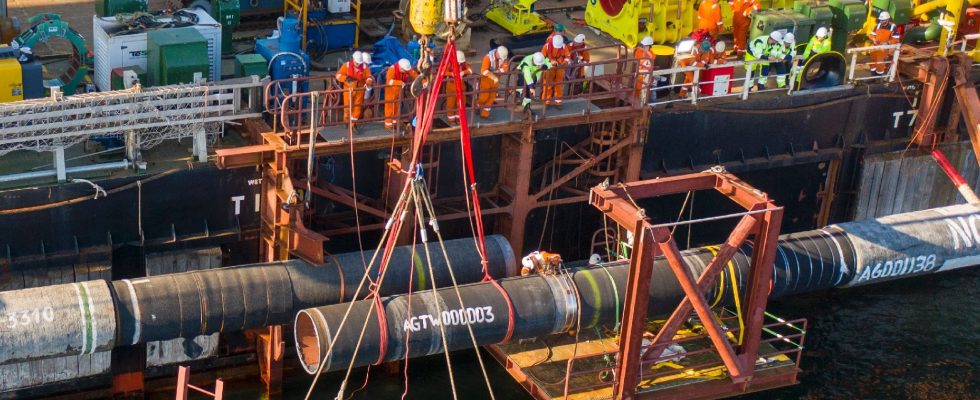A year after the sabotage of the Nord Stream gas pipeline transporting natural gas from Russia to Germany, a new leak worries and raises questions from Europe. The operation of the bidirectional gas pipeline, which sent gas from Finland to the Baltic states in summer, and vice versa in winter, was interrupted on Sunday due to a leak. The last gas pipeline still in service in the country, after the cessation of Russian imports, is therefore inoperable.
Finnish investigators did not find any signs of the use of explosives, but the Norwegian Institute of Seismology detected a “probable explosion” in the area of the leak. The telecommunications cable accompanying the gas pipeline was damaged in Estonian waters, officials from this Baltic country said on Tuesday during a press briefing.
Damage noted on the gas pipeline and on a telecommunications cable
This incident comes after that of the Nord Stream, on September 26, 2022, the origin of which still remains an enigma since none of the three judicial investigations opened separately by Germany, Sweden and Denmark have yet been successful. Four huge gas leaks preceded by underwater explosions had occurred on Nord Stream 1 and 2, pipelines which transported most of Russian gas to Europe.
But unlike this episode, where seismologists recorded two separate explosions, scientists did not measure any unusual activity near the Finnish pipeline. In addition to the gas pipeline, a “disruption” affects the submarine telecoms cable linking Finland and Estonia via the Gulf of Finland but no customers were affected, according to the telecoms operator Elisa.
The Estonian Navy is investigating the damage to this cable. “It is likely that the damage to the gas pipeline and telecommunications cable was the result of external activity,” Finnish President Sauli Niinistö said in a statement. The cause of the leak on the gas pipeline is not yet clear and “the investigation continues, in cooperation between Finland and Estonia,” said the Finnish president.
“The extent of the damage is such that it must have been caused by a force, which was not, for example, a diver or a small underwater robot, the damage is more massive,” said for his part Estonian Defense Minister Hanno Pevkur during a press conference. Asked about possible Russian involvement, Finnish Prime Minister Petteri Orpo warned against any premature conclusions. “There are no indications (to say) that explosives were used,” said Timo Kilpeläinen, head of investigations at the National Bureau of Investigation (NBI). The Norwegian seismology institute Norsar has, for its part “detected a probable explosion off the Finnish coast of the Baltic Sea at 1:20 a.m. on October 8, 2023”, according to its press release.
European and NATO support
Finland received support from NATO, of which it became a member in April after decades of neutrality. The Alliance’s secretary general, Jens Stoltenberg, said he was in contact with the Finnish president and was ready to support the country.
The Alliance further recalls that it “is working to strengthen the security of underwater infrastructure. The President of the European Commission, Ursula von der Leyen, declared that she “strongly condemns any act of deliberate destruction of “critical infrastructure”, following talks with the Prime Ministers of Finland and Estonia. This year, NATO announced the creation of a Critical Underwater Infrastructure Coordination Cell at NATO Headquarters. The alliance and the European Union have also established a joint task force to protect critical infrastructure.
Gasgrid, manager of the gas pipeline, assured that it would be able to prepare “repair plans” and a work schedule once the origin of the leak has been established. In the meantime, the situation in the Finnish gas system is stable and supply from the floating liquefied natural gas (LNG) terminal in Inkoo (south) is assured, the state company stressed in a press release.
Pay bills in rubles
Russia stopped supplying natural gas to Finland via pipeline after the Nordic country refused to pay Moscow in rubles. Following Russia’s invasion of Ukraine, Moscow asked customers in “unfriendly countries”, including European Union member states, to pay their gas bills in rubles, a way of avoid Western financial sanctions against its central bank.
Natural gas, which accounts for around 5% of Finland’s energy consumption, is used mainly in industry and combined heat and power production. A little earlier Tuesday, and while gas stocks are full for the winter, the International Energy Agency (IEA) warned of possible tensions in Europe on the gas market, particularly in the event of cold winter and new restrictions on Russian gas deliveries in gas pipelines, according to a report on the gas market outlook for 2026. On the same day, gas prices on the Rotterdam TTF, the main indicator of the European market, jumped again by more than 12%, getting closer to 50 euros per megawatt hour for delivery in November.
